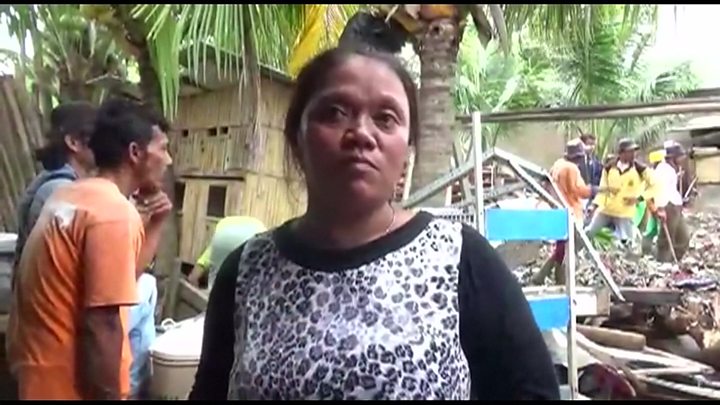Indonesia tsunami death toll rises
The death toll following the tsunami caused by the Anak Krakatau volcano has risen to at least 373, Indonesia’s disaster mitigation agency says.
Saturday saw giant waves crash into coastal towns on the islands of Sumatra and Java.
It is thought that volcanic activity set off undersea landslides which in turn generated the killer waves.
“1,459 people are injured, while 128 remain missing,” said agency spokesman Sutopo Purwo Nugroho in a statement.
Coastal residents near the volcano have been warned to keep away from beaches amid fears it could trigger a new tsunami.
Anak Krakatau erupted again on Sunday, spewing ash and smoke.
Video shot from a charter plane captured the magnitude of the volcanic event in the Sunda Strait, between Sumatra and Java.
Rescue efforts are being hampered by blocked roads but heavy lifting equipment is being transported to badly hit areas to help search for victims.
What warning was given?
The spokesman for the National Disaster Management Agency told a news conference that another tsunami is a possibility because of the continued volcanic eruptions of Anak Krakatau.
“Recommendations from [the] Meteorology, Climatology and Geophysical Agency are that people should not carry out activities on the beach and stay away from the coast for a while,” he said.
Anak Krakatau, which emerged in 1927 from the caldera that was formed during the eruption of Krakatoa in 1883, has seen increased activity in recent months with people asked to avoid the area around its crater.
On Monday Mr Sutopo put out a series of tweets explaining why there was no early warning for this tsunami. He said that Indonesia’s early warning system is set up to monitor earthquakes but not undersea landslides and volcanic eruptions, which can also generate deadly waves.
But, he added, with 13% of the world’s volcanoes in Indonesia alone, it was crucial for the country to develop such system.
He confirmed there was no tsunami advance warning system on the night of the disaster, adding that because of lack of funds, vandalism to the buoys and technical faults there had been no operational tsunami warning system since 2012.
Why was Saturday’s tsunami so deadly?
The tsunami struck at 21:30 local time (14:30 GMT) during a local holiday, with few of the warning signals that might have come had it been generated by an earthquake.
Seawater did not recede as it would with an earthquake tsunami and experts say that even if there had been warning buoys near the volcano, there would have been minimal alert time.
The waves destroyed hundreds of buildings, sweeping away cars and uprooting trees in several popular tourist destinations, including the Tanjung Lesung beach resort, west Java.
Footage shared on social media showed a large wave crashing into a tent in the resort, in which popular Indonesian rock band Seventeen were performing.
Members of the band were seen being swept away as the wave destroyed the stage.
How did the tsunami happen?
By Jonathan Amos, BBC science correspondent
Everyone in the region will have been aware of Anak Krakatau, the volcano that emerged in the sea channel just less than 100 years ago. But its rumblings and eruptions have been described by local experts as relatively low-scale and semi-continuous.
In other words, it’s been part of the background.
And yet it is well known that volcanoes have the capacity to generate big waves. The mechanism as ever is the displacement of a large volume of water.
The first satellite imagery returned after the event on Saturday points strongly to a collapse in the west-southwest flank of the volcano. This would have sent millions of tonnes of rocky debris into the sea, pushing out waves in all directions.
How common are tsunamis in Indonesia?
Indonesia is prone to tsunamis because it lies on the Ring of Fire – the line of frequent earthquakes and volcanic eruptions that circles virtually the entire Pacific Rim.
In September, more than 2,000 people died when a powerful earthquake struck just off the central Indonesian island of Sulawesi, setting off a tsunami that engulfed the coastal city of Palu.
On 26 December 2004, a series of huge waves triggered by a powerful earthquake in the Indian Ocean killed about 228,000 people in 13 countries, mostly in Indonesia.
However, tsunamis caused by volcanic activity like this are less frequent.
Krakatoa (Krakatau in Indonesian)
In August 1883, Krakatoa underwent one of the most violent volcanic eruptions in recorded history:
Are you in the affected area? If it is safe to do so, get in touch by emailing [email protected]. or WhatsApp us on +44 7555 173285
Please include a contact number if you are willing to speak to a BBC journalist. You can also contact us in the following ways:
Or use the form below:
If you are happy to be contacted by a BBC journalist please leave a telephone number that we can
contact you on. In some cases a selection of your comments will be published, displaying your name as
you provide it and location, unless you state otherwise. Your contact details will never be published.
When sending us pictures, video or eyewitness accounts at no time should you endanger yourself or others,
take any unnecessary risks or infringe any laws. Please ensure you have read the terms and conditions.
Terms and conditions
The BBC’s Privacy Policy
Source: Read Full Article



